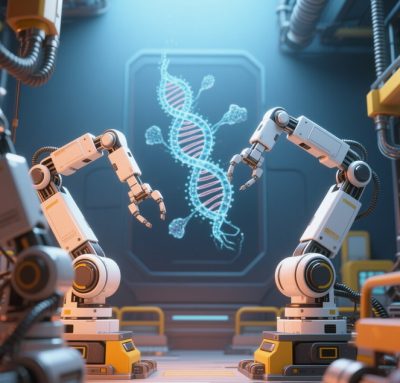
Latest Applications of Neurotech BCI in Global Industrial and Human-Machine Collaboration (As of April 2025)
1. Paradigm Shift in Industrial Automation and Smart Manufacturing
Production Line Optimization
BCI systems dynamically adjust robotic workflows by monitoring operators’ brain signals (e.g., attention and fatigue levels) in real time. For example:
- Adaptive Control: Systems automatically slow robotic arms when detecting distracted attention, reducing accident risks while improving assembly efficiency.
- Case Study: At the “China Brain Valley” project in Tianjin, BCI-integrated industrial robots achieve full brain-controlled automotive part assembly with error rates below 0.3%.
Hazardous Environment Operations
BCI-powered exoskeletons and robotic arms enable operations beyond human physiological limits:
- Remote Control: Beihang University’s 1.5kg BCI system directs deep-sea robots for 10km-depth pipeline inspections with sub-50ms latency.
- High-Temperature Handling: Workers mentally control heat-resistant robotic arms to manipulate molten metals, minimizing exposure risks.
Human-Machine Training
- Neuro-Digital Twins: Brainwave feedback simulates complex equipment operations. For instance, aircraft maintenance trainees use EEG headsets to receive personalized skill assessments based on neural patterns.
2. Intelligent Logistics and Supply Chain Management
Warehouse Sorting
- Mind-Controlled AGV Collaboration: Operators visually focus on target items, while AGVs locate and retrieve goods via brain signals, boosting sorting efficiency by 30%.
- Emergency Response: Systems switch to autonomous mode and trigger alerts upon detecting abnormal brain activity (e.g., sudden dizziness).
Transportation Safety
- Fatigue Detection: BCI monitors α/β wave ratios in real time, activating autonomous driving when fatigue thresholds are exceeded.
- Emergency Braking: P300 brain potential-triggered braking systems react faster than manual controls, significantly reducing accident rates.
3. Cutting-Edge Military and Complex System Collaboration
Drone Swarm Control
- Mind-Driven Swarms: The U.S. military’s “Silent Command” project enables single operators to control six drones for reconnaissance and strikes using prefrontal cortex signals.
- Battlefield Coordination: Soldiers share tactical intent via BCI helmets, enhancing squad synchronization.
Human-Machine Augmentation
- Exoskeleton Enhancement: BCI-driven exoskeletons dynamically adjust power output based on motion intent and muscle-brain synergy, optimizing energy distribution during heavy-load tasks.
4. Technological Innovations and Industrial Breakthroughs
| Technical Focus | Breakthrough | Case Study |
|---|---|---|
| Signal Fidelity | Hybrid EEG/fNIRS systems triple spatiotemporal resolution for intent recognition in complex industrial settings. | Tianjin Brain Bay Lab’s multimodal BCI platform. |
| Individual Adaptation | Transfer learning reduces personalized training time from 120 to 20 hours. | Shenzhen-Shanghai customized BCI production lines. |
| Quantum Integration | USTC’s NV center magnetic sensing achieves single-neuron signal resolution, targeting industrial validation by 2030. | Quantum BCI factory-wide monitoring networks. |
5. Ethical Challenges and Global Industrial Ecosystem
Data Security and Sovereignty
- Localized Storage: The EU’s Neurotechnology Ethics Framework and Shanghai’s regulations mandate onshore storage of industrial BCI data.
- Access Control: Blockchain encryption ensures operator brain data shares only essential parameters with control systems.
Industry Collaboration
- Innovation Alliances: The Beijing-Tianjin-Hebei BCI Alliance unites 200+ companies to standardize BCI-robot interfaces.
- Funding Models: China’s BCI Innovation Fund supports industrial-grade solutions through early-stage investments and tech incubation.
Global Competition
- China’s Edge: “Brain Valley” clusters in Tianjin and Shanghai drive 35% of global BCI industrial patents.
- Technical Barriers: U.S.-based Blackrock Neurotech’s five-generation lead in invasive electrodes challenges China’s high-end equipment development.
6. Future Trends and Strategic Directions
Quantum-BCI Integration
- USTC plans to deploy factory-wide quantum sensing networks by 2030, monitoring neural states across thousands of operators in real time.
Self-Evolving Systems
- Dynamic Protocol Generation: BCI combined with generative AI auto-generates human-machine interaction rules based on brain signal patterns.
- Collective Neuro-Intelligence: Aggregated operator brain signals train AI models to optimize complex decision-making processes.
Cost Reduction and Accessibility
- Wearable BCI: 3D-printed flexible headsets enable at-home training with 5G cloud connectivity to medical platforms.
- Consumer Market: Meta’s AR glasses integrate BCI for meditation and focus management, surpassing 1 million units sold in 2024.
Conclusion
Neurotech BCI is expanding from healthcare into industrial and collaborative robotics, merging human cognitive flexibility with machine precision. Current advancements span single-point control (e.g., robotic arms) to system-level coordination (e.g., drone swarms). Over the next decade, quantum sensing and autonomous AI integration will propel industrial BCI into a “programmable neuro-era.” To lead the global Industry 4.5 revolution, China must address bottlenecks in foundational materials (e.g., graphene electrodes) and algorithm ecosystems (e.g., PyTorch dependency).
Data sourced from publicly available information and subject to verification.





